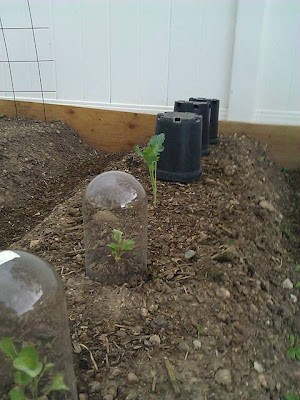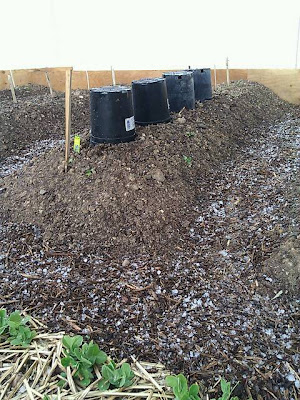Recently, I dropped by our local nursery to pick up a few additional items that we needed to have. One of those items was another five pounds of Yukon Gold potatoes.
While we were sorting through the 'taters, an older couple was there looking to get some as well and asked us if we'd ever grown them. I was actually pretty shocked, after we said "yes, many times", when they asked us, "what are tubers?" (The sign on the display referenced tubers) I guess I shouldn't be... shocked that is... but I was. I guess our disconnect from our food has been going on longer than I had imagined. We talked to then for a little while, giving them a basic primer in potato growing 101, and went our separate ways. It got me to thinking that this may be a really good time to go over some of the basics of growing potatoes. I Usually have my potatoes in the ground around St Patrick's Day, but this year it's been so rainy and wet - Locally our watershed levels are averaging around 160%-170% of our normal level - that I haven't been able to get them into the ground. I probably could have squeezed them in at some point, but I think I would have suffered from a lot of rot if I had.
First of all, the potatoes themselves are the tubers; and tubers are "...various types of modified plant structures that are enlarged to store nutrients. They are used by plants to survive the winter or dry months and provide energy and nutrients for regrowth during the next growing season..." (
wikipedia). Just needed to get that straight from the start.
Potato's are plants in the solanaceae family. That makes them cousins with plants like Tomatoes, Peppers and Eggplants. If you think about the way that those plants bear fruit, you'll have a pretty good idea of the way that potatoes bear their tubers as well. Many folks think that potatoes grow from the roots of the plant, an understandable thing considering the photo above, it does look like they've grown from the roots, But take a look at this photo:
You can see the seed potato that was placed in the ground and can clearly see that the small potatoes are growing from the stem ABOVE the planted potato. Think again about tomatoes... if you pay attention to them they actually grow from a small stem that grows from the main stem. Potatoes are the same, except that they only grow on the stem that is underground. Because of that, they are planted a little differently.

This might look a lot like how you would lay out any other plant before putting it in the ground. The difference here is that I'm not going to plant them into the hills, but rather will bury them a couple of inches under the soil at the bottom of the furrows. I lay the potatoes out so I know how many I can fit in a row, then dig them in and leave them alone. Potatoes don't need to be watered in because the tuber itself is mostly water itself and is designed by mother nature to support this plant as it gets itself established. I let my potatoes grow until they are nearly a foot tall before I ever irrigate them. The spring rains take care of that for me. After the Potato plants have grown up enough to be five or six inches above the ground, I will then rake or hoe the soil from the hills over and onto the plant itself. After this, I let the plant grow further. When it's another five or six inches above ground level again, I will hoe the soil up onto the plant again leaving furrows between the plants that I will flood irrigate once or twice a week.

As the weather turns hotter and the plants are getting taller, I want to keep mounding over the plants as much as possible, and mulching to keep the moisture level steady and weeds down. Grass clippings work great for this. The reason, in case you were wondering, why I keep mounding soil and mulch over the plants is because, as I said, the actual potatoes grow from the stems above the seed potato, but only where it's covered. I want to make sure that there's as much stem underground as possible when the potatoes are growing. So, the long and the short of it is that with a little understanding about the way that potatoes grow and some of the ways that you can coax them along and get great returns for yourself.
Best of luck with your tater growing!
Paul~








 The Honey and water wort (The base of the recipe)
The Honey and water wort (The base of the recipe) The "additives" like irish moss, gypsum and spearmint tea...
The "additives" like irish moss, gypsum and spearmint tea... Adding the pears for sugar and bouquet. (If you're going to learn to make mead, you should of course learn from a man with celtic knots on his arms yes?)
Adding the pears for sugar and bouquet. (If you're going to learn to make mead, you should of course learn from a man with celtic knots on his arms yes?)


